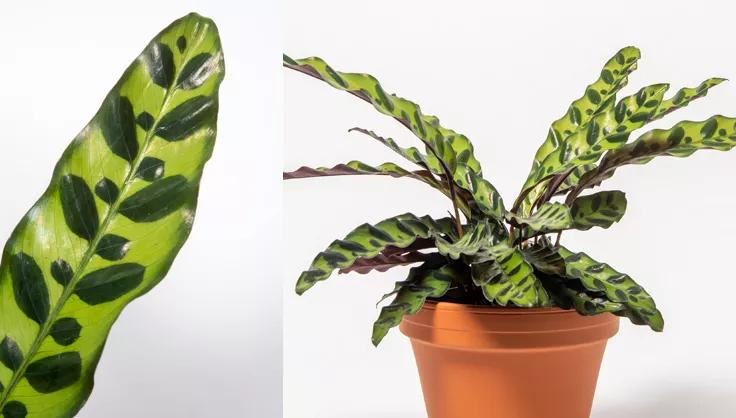How to Grow & Care for a Calathea

Native to the tropics of Central and South America, calatheas appreciate warm, humid air — mimic these conditions as best as you can in your home, and you'll have a thriving calathea!
Types of Calathea
There are upwards of 50 different species of calathea, and many cultivated varieties of each. However all are characterized by vibrant leaves and a love of high humidity.
Calathea lancifolia: Known as the rattlesnake plant, due to its wavy leaves with green and bold burgundy snake-like patterns, this plant is widely available and very popular.
Calathea orbifolia: With wider, more paddle-like leaves than C. lancifolia, this species has slender green and white striping.
Calathea makoyana: Peacock-patterned leaves on a compact, small plant.
Calathea crocata: This species is known for its bright orange flowers, which contrast beautifully with its rich green and maroon foliagee.
Calathea warscewiczii: A taller species that can grow to 3-4 feet in height, this plant has velvety-textured leaves.
Best Growing Conditions for Calatheas
Light
As natives to the rainforest floor, where they received sun gently filtered through the tree canopy, calatheas prefer medium to low indirect light. Too much direct sunlight can bleach and burn their delicate leaves. A spot near an east or north-facing window is ideal.
Soil
These plants thrive in well-draining, slightly acidic soil. A mix of potting soil, peat, and perlite works well. Fertilize every month during the growing season with a balanced, diluted houseplant fertilizer, but refrain from fertilizing in the winter.
Humidity
These plants love humidity (they are native to tropical rainforests, after all!) so consider grouping several together to boost collective humidity or adding a humidifer to the room.
How To Care For Calathea
Watering
Calatheas prefer consistently moist soil but not soggy. Use lukewarm water to avoid shocking the plant and allow the top inch of the soil to dry out between waterings. They are sensitive to fluoride and other chemicals in tap water, so filtered or rainwater is best.
Pruning
Regular pruning is not necessary, but you can remove yellow or brown leaves to keep the plant looking its best. Use clean, sharp scissors to prevent damage.
Repotting
Repot Calatheas every one to two years or when they outgrow their pot. Spring is the best time for repotting. Choose a pot only slightly larger than the current one to prevent overwatering.
Propagation
Propagation is typically done by division during repotting. Gently separate the plant into smaller sections, making sure each has roots, and pot them separately.
Common Problems with Calatheas
Pests and Diseases
Common pests include spider mites, aphids, and mealybugs. High humidity is a must for these plants, but can also attract fungal diseases like leaf spot. Regularly check your plant and treat any infestations or diseases promptly.
Toxicity
In addition to their bright foliage, calathea's are also prized for their non-toxic nature. Calatheas are a safe choice for households with animals and children.
Calathea FAQs
Q: Why is my calathea losing its colorful pattern?
A: Too much direct sun can "burn" leaves and dull the coloring. Calathea like warm, ambient light — keep in a bright room but move away from thte. window.
Q: My calathea's leaves are curling. What should I do?
A: Calathea plants have very expressive leaves! Leaf curling usually indicates that the plant is not getting enough water or the humidity is too low. Ensure a consistent watering schedule and consider using a humidifier or setting the plant on a pebble tray containing a small amount of water.
Q: How often should I water my Calathea?
A: The frequency of watering depends on the humidity and light conditions in your home. Generally, water when the top inch of soil feels dry. Always avoid letting the soil dry out completely — this plant doesn't want to sit in a puddle, but it does appreciate consistent moisture.
The key to thriving calatheas is to mimic their naturally humid and warm tropical environment as much as possible — keep away from drafty doors and consider boosting the room with a humidifier. With a little patience and care, your calathea will be a lush and long-lived member of your indoor garden!
Print this Article:
Get the Dirt
Stay up to date on new articles and advice. Please fill out the information below.
